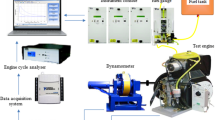Abstract
In an era in which environmental pollution and depletion of world oil reserves are of major concern, emissions produced by automotive vehicles need to be controlled and reduced. An ideal solution is to switch to a cleaner fuel such as natural gas, which generates cleaner emissions. In addition, control over the in-cylinder air-fuel mixture can be best achieved through a direct-injection mechanism, which can further improve combustion efficiency. This need for cleaner automobiles provides the motivation for this paper’s examination of the use of computational fluid dynamic (CFD) simulations to analyze the concentrations of the exhaust gases produced by a compressed natural gas engine with a direct-fuel-injection system. In this work, a compressed natural gas direct-injection engine has been designed and developed through a numerical simulation using computational fluid dynamics (CFD) to provide an insight into complex in-cylinder behavior. The emissions analyzed in this study were carbon monoxide (CO), nitric oxide (NO) and carbon dioxide (CO2), i.e. the main pollutants produced by natural gas combustion. Based on a stoichiometric mixture, the concentrations of CO and NO were computed using the dissociation of carbon dioxide and the extended Zeldovich mechanism. CO2 was calculated using a mass balance of the species involved in the combustion process. The simulation results were then compared with the experimental data generated by a single-cylinder research engine test rig. A good agreement was obtained with the experimental data for the engine speeds considered for all emissions concentrations.
Similar content being viewed by others
Abbreviations
- ρ :
-
density
- µ:
-
dynamic viscosity
- c ν :
-
heat capacity at constant volume
- k :
-
thermal conductivity coefficient
- g :
-
gravitational acceleration
- u :
-
velocity vector
- λ :
-
viscous stress tensor
- p :
-
pressure
- T :
-
temperature
References
Abdullah, S., Kurniawan, W. H. and Shamsudeen, A. (2008). Numerical analysis of the combustion process in a com-pressed natural gas direct injection engine. J. Applied Fluid Mechanics 1,2, 65–86.
Abianeh, O. S., Mirsalim, M. and Ommi, F. (2009). Combustion development of a bi-fuel engine. Int. J. Automotive Technology 10,1, 17–25.
Agarwal, A. and Assanis, D. N. (2000). Multi-dimensional modeling of ignition, combustion and nitric oxide formation in direct injection natural gas engines. SAE Paper No. 2000-01-1839.
Barths, H., Hasse, C. and Peters, N. (2000). Computational fluid dynamics modelling of non-premixed combustion in direct injection diesel engines. Int. J. Engine Research 1,3, 249–267.
Belardini, P. and Bertoli, C. (1999). Multi-dimensional modelling of combustion and pollutants formation of new technology light duty diesel engines. Oil & Gas Science and Technology — Rev. IFP, 54, 251–257.
Borman, G. L. and Ragland, K. W. (1998). Combustion Engineering. McGraw-Hill. New York.
Chen, R. and Milovanovic, N. (2002). A computational study into the effect of exhaust gas recycling on homogeneous charge compression ignition combustion in internal combustion engines fuelled with methane. Int. J. Thermal Science, 41, 805–813.
Cho, H. M. and He, B. Q. (2008). Combustion and emission characteristics of a lean burn natural gas engine. Int. J. Automotive Technology 9,4, 415–422.
Choa, H. M. and Heb, B. Q. (2007). Spark ignition natural gas engines — A review. Energy Conversion & Management 48,2, 608–618.
Duclos, J. M., Zolver, M. and Baritaud, T. (1999). 3D modeling of combustion for DI-SI engines. Oil & Gas Science and Technology — Rev. IFP 54,2, 259–264.
El-Tahry, S. H. (1983). k-ɛ equation for compressible reciprocating engine flows. AIAA J. Energy 77,4, 345–353.
Huang, Z., Shiga, S., Ueda, T., Nakamura, H., Ishima, T., Obokata, T., Tsue, M. and Kono, M. (2003). Effect of fuel injection timing relative to ignition timing on the natural gas direct-injection combustion. J. Engineering for Gas Turbines and Power, 125, 783–790.
Launder, B. E. and Spalding, D. B. (1972). Lectures in Mathematical Models of Turbulence. Academic Press Inc. London.
Magnussen, B. F. (1981). On the structure of turbulence and a generalised eddy dissipation concept for chemical reaction in turbulent flow. Proc. Nineteenth AIAA Aerospace Meeting. St. Louis, Missouri, USA.
Selamet, E. E., Selamet, A. and Novak, J. M. (2004). Predicting chemical species in spark-ignition engines. Energy, 29, 449–465.
Shiga, S., Ozone, S., Machacon, H. T. C., Karasawa, T., Nakamura, H., Ueda, T., Jingu, N., Huang, Z., Tsue, M. and Kono, M. (2002). A study of the combustion and emission characteristics of compressed-natural-gas direct-injection stratified combustion using a rapid-compression-machine. Combustion and Flame, 129, 1–10.
Soylu, S. (2005). Examination of combustion characteristics and phasing strategies of a natural gas HCCI engine. Energy and Conversion Management, 46, 101–119.
Turns, S. R. (1999). An Introduction to Combustion — Concepts and Applications. 2nd Edn. McGraw-Hill. Boston.
Wang, J., Huang, Z., Miaoa, H., Wanga, X. and Jianga, D. (2008). Characteristics of direct injection combustion fuelled by natural gas-hydrogen mixtures using a constant volume vessel. Int. J. Hydrogen Energy 33,7, 1947–1956.
Zellat, M., Duranti, S., Liang, Y. J., Kralj, C., Schmidt, G. and Duclos, J. M. (2005). Towards a universal combustion model in STAR-CD for IC engines: from GDI to HCCI and application to DI Diesel combustion optimization. Proc. 14th Int. Multidimensional Engine User’s Meeting, SAE Cong., Detroit, Michigan, USA.
Zeng, K., Huang, Z. H., Liu, B., Liu, L. X., Jiang, D. M., Ren, Y. and Wang, J. H. (2006). Combustion characteristics of a direct-injection natural gas engine under various fuel injection timings. Applied Thermal Engineering, 26, 806–813.
Zhang, D. H. and Frankel, S. H. (1998). A numerical study of natural gas combustion in a lean burn engine. Fuel 77,12, 1339–1347.
Zheng, Q. P., Zhang, H. M. and Zhang, D. F. (2005). A computational study of combustion in compression ignition natural gas engine with separated chamber. Fuel, 84, 1515–1523.
Author information
Authors and Affiliations
Corresponding author
Rights and permissions
About this article
Cite this article
Abdullah, S., Kurniawan, W.H., Khamas, M. et al. Emission analysis of a compressed natural gas directinjection engine with a homogenous mixture. Int.J Automot. Technol. 12, 29–38 (2011). https://doi.org/10.1007/s12239-011-0004-1
Received:
Revised:
Published:
Issue Date:
DOI: https://doi.org/10.1007/s12239-011-0004-1




